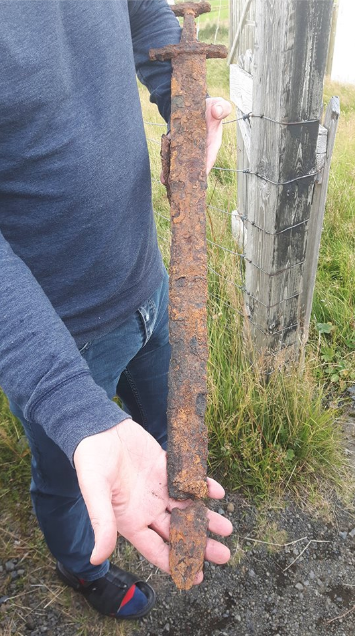A research unit from the Cultural Heritage Agency of Iceland has not discovered more artifacts in the area where goose hunters found a 1000-year old Viking sword last Friday.

A preliminary excavation by five archeologists and a osteologist (bone expert) has not revealed the origin of the beautifully preserved sword. “We found no signs of human habitats in the area, so this remains a mystery,” said archeologist Uggi Sævarsson in an interview with The National Broadcasting Service.
The goose hunters found the sword where it lay exposed on the surface of the sand banks of a small lagoon in Eldvatn river in South Iceland.
Most likely the sword washed out from a viking age burial site (called “kuml” in Icelandic) further inland in the large glacial outburst flood that occurred in the area last autumn (September 2015).
The flood originated at Skaftárkatlar (Skaftá depressions) beneath Vatnajökull glacier, which is Europe largest glacier south of the Arctic Circle. Floods occur when melt water from geothermal energy fill up the sub glacial depressions lifting up the glacier and forging a path for itself under the ice and the bursting out over the ice free area.
Eldvatn river runs west along the Skaftártunga area and into the Kúðafljót River on its way to the Atlantic ocean. The area is around 270 km (168 mi) to the east from Reykjavík.

A research unit from the Cultural Heritage Agency of Iceland has not discovered more artifacts in the area where goose hunters found a 1000-year old Viking sword last Friday.

A preliminary excavation by five archeologists and a osteologist (bone expert) has not revealed the origin of the beautifully preserved sword. “We found no signs of human habitats in the area, so this remains a mystery,” said archeologist Uggi Sævarsson in an interview with The National Broadcasting Service.
The goose hunters found the sword where it lay exposed on the surface of the sand banks of a small lagoon in Eldvatn river in South Iceland.
Most likely the sword washed out from a viking age burial site (called “kuml” in Icelandic) further inland in the large glacial outburst flood that occurred in the area last autumn (September 2015).
The flood originated at Skaftárkatlar (Skaftá depressions) beneath Vatnajökull glacier, which is Europe largest glacier south of the Arctic Circle. Floods occur when melt water from geothermal energy fill up the sub glacial depressions lifting up the glacier and forging a path for itself under the ice and the bursting out over the ice free area.
Eldvatn river runs west along the Skaftártunga area and into the Kúðafljót River on its way to the Atlantic ocean. The area is around 270 km (168 mi) to the east from Reykjavík.








